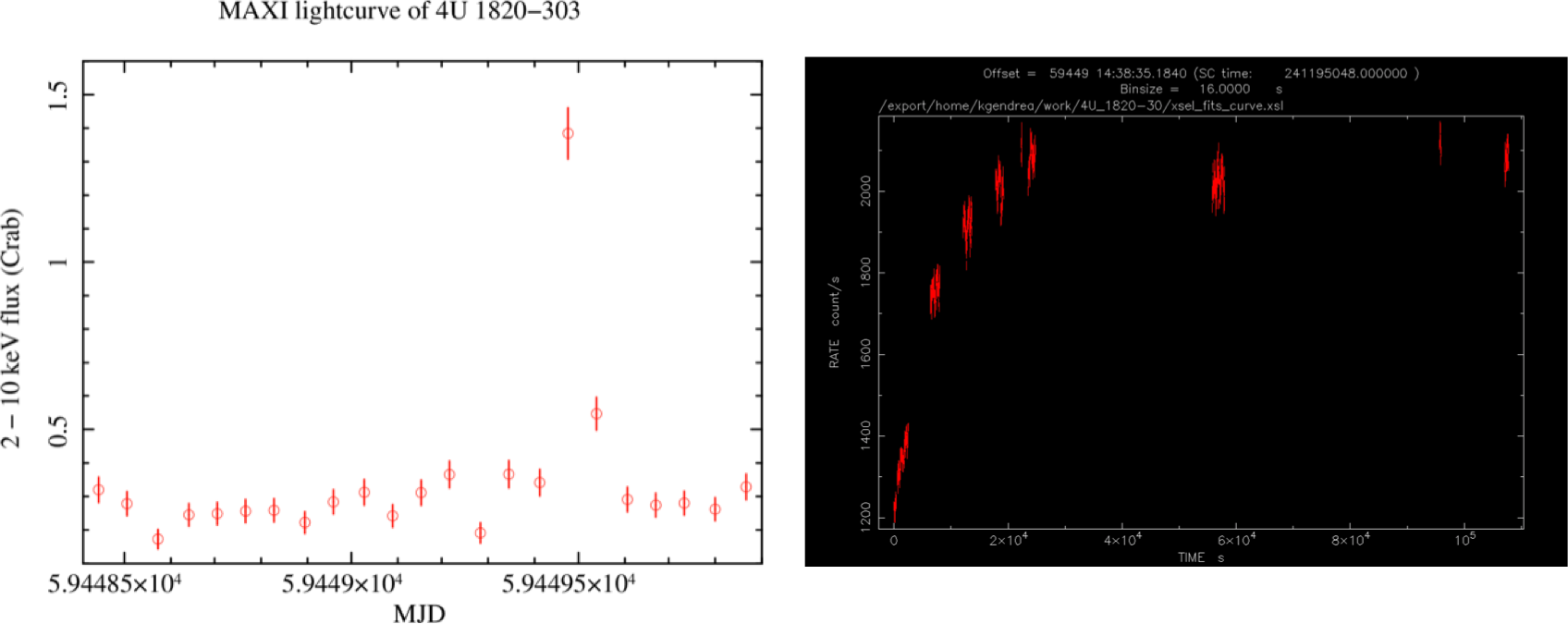NICER / ISS Science Nugget
for August 26, 2021
MAXI Triggers NICER Observations of a Superburst's After-effects
Shortly before noon UT on 23 August, JAXA's MAXI payload detected a sudden brightening, by a factor of almost 5x, of the well-known X-ray binary system 4U 1820-30, which consists of a neutron star accreting matter from a low-mass helium-rich companion star. The two objects complete an orbit around one another every 11 minutes, making 4U 1820 one of a handful of known "ultracompact" binaries (UCBs). Within an hour, the MAXI team alerted (via email) the NICER team of 4U 1820's increased brightness, which however faded to just 75% of the system's typical, persistent brightness by the next ISS orbit (Figure 1). One orbit later still, NICER was able to make its first of several observations.
Such bursts of X-ray emission from accreting binary systems are the result of explosive thermonuclear fusion reactions just beneath the surface of a neutron star that has accumulated light-element fuel to beyond a critical density. The duration and brightness of a burst depend on the type of fuel. Hydrogen- and helium-fueled explosions last tens of seconds up to a few minutes, and are much more common. The brightest and longest-duration bursts, fading over hours, are the result of burning carbon, which is not directly accreted from the companion star but instead accumulates as the end-product of helium-fusion bursts. Thus, these "superbursts" are rare events, occurring in a given system once every few years, but on average approximately once a year somewhere in the sky across multiple Galactic X-ray binaries.
NICER's observations of the likely 4U 1820 superburst this week show that the system's persistent emission dropped by a factor of two immediately after the event, but recovered in the span of approximately 5-6 hours (Figure 2). The leading interpretation of this behavior is that the burst disrupted the flow of matter from the companion star; the small but superheated accretion disk responsible for the persistent emission then rapidly refilled. This is consistent with the behavior of another UCB, IGR J1706, seen by NICER following an apparent superburst and reported here on 2 July 2020. With its longer, 38-minute, orbital period, the IGR J1706 system is larger and the full recovery of the accretion disk took more than 2 days.
The much-anticipated OHMAN (Orbiting High-energy Monitor Alert Network) capability will soon link MAXI and NICER, to trigger NICER follow-up of MAXI detected events on minutes, instead of hours, timescales and without ground intervention. OHMAN will enable unique insights into the mechanisms of long-duration bursts and their effect on accretion in neutron star systems.

Figure: Left: The MAXI Gas Scintillation Camera lightcurve of 4U 1820-30 around the long-duration burst seen on Modified Julian Day 59,449. Right: NICER's lightcurve of 4U 1820-30, beginning approximately two ISS orbits after the burst peak detected by MAXI. On the scale of this figure, short dips in count-rate with the 11-minute orbital period of the binary system are just visible in each 30-40 minute observation.
<< Previous
Main Index
Next >>